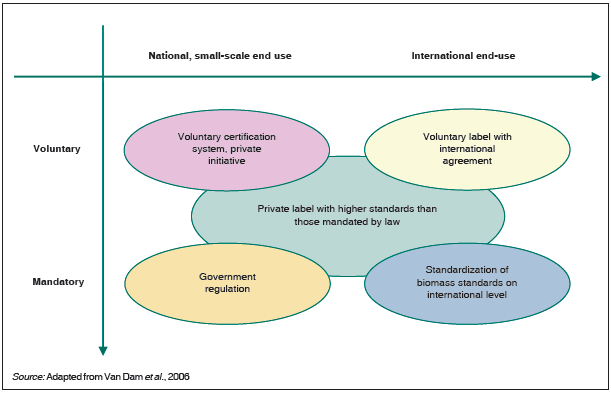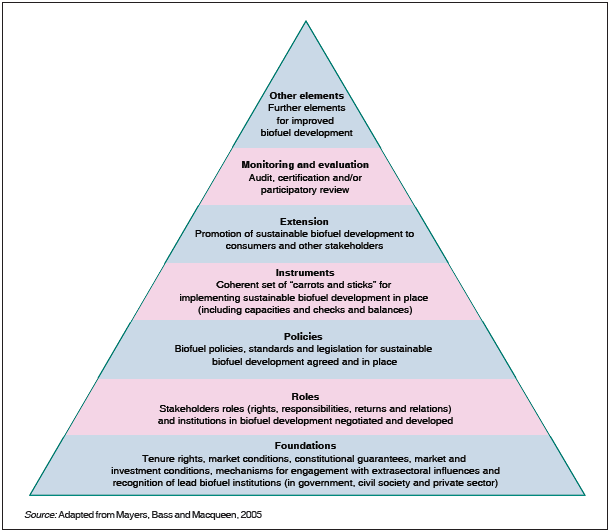O. Dubois
Olivier Dubois is Senior Rural Institutions Officer and Coordinator of the Bioenergy Group, Environment, Climate Change and Bioenergy Division, Natural Resources Management and Environment Department, FAO, Rome.
Adapted from the author’s paper “How good enough biofuel governance can help rural livelihoods: making sure that biofuel development works for small farmers and communities”, an unpublished background paper for FAO’s State of Food and Agriculture 2008.
Some suggestions on how to achieve biofuel development that favours sustainable rural livelihoods.
The quest for sustainable biofuel systems has increased tremendously over the past few years. Concerns about potential negative effects, such as deforestation and competition between food and biofuel production, have led to the demand for sustainability instruments such as standards, criteria and indicators to be applied through mandatory regulations and/or voluntary schemes such as certification.
To ensure that biofuels contribute to the Millennium Development Goals, and in particular to the first goal on food security and poverty reduction, it is important to ensure that biofuel development at least does not harm, and preferably favours, the livelihood strategies of small-scale producers and communities in rural areas. This article addresses what it takes to achieve biofuel development that favours sustainable rural livelihoods.
Biofuel systems are complex because:
Biofuel development is also strongly influenced by current global trends such as transition to market economies, globalization, high and volatile fossil fuel prices and rising concerns about climate change. Yet biofuel development should be geared to people’s livelihoods as well as to global and national energy needs. Livelihoods are sustainable (Ashby and Carney, 1999) when they:
The article briefly discusses governance mechanisms that can ensure that small farmers and communities in rural areas do not lose out from the implementation of biofuel schemes.
Biofuel systems can be developed in diverse land-use situations (Figure 1). Conventional management methods are efficient in differentiating these land uses according to physical criteria. However, actual land uses change not only according to physical factors but also because needs change as demands from society, market opportunities and stakeholders’ entitlements evolve. It is therefore important to consider the dynamics of land uses when assessing their environmental, economic and social impacts. Table 1 illustrates this through the different possible trajectories of forest cover, income and population density. In particular, it shows that different land cover trajectories are caused by and contribute to livelihood needs in different ways, and change over time.
It is increasingly accepted that modern policies and planning strategies regarding land use and natural resource management should account for “unpredictables” and “unknowns”, hence uncertainty in land use and natural resource management (Dubois, 2003). They should be adaptive, following a learning process and involving continuous monitoring of the dynamics of environmental and socio-economic changes. And they should take into account the political dimension of land use and natural resource management, including power relationships, and develop approaches to deal with this dimension.
Uncertainty concerns not only ecological but also socio-economic circumstances, leading to different forms of vulnerability in rural areas. The aim of sustainable development should therefore be to manage, in time and space, change resulting from interactions among ecological, economic and socio-political factors.
| 1 Land-use spectrum as basis for biofuel development |
 |
Approaches and instruments to achieve sustainable biofuel development can be characterized according to their mandatory or voluntary character as well as the scale of their application, as illustrated in Figure 2 (Van Dam et al., 2006).
The performance of regulatory and voluntary instruments in terms of small farmers’ and communities’ livelihoods cannot yet be evaluated for biofuel development on a global scale because it is so recent, but lessons can be drawn from other types of land uses. Experience with forest resource management, for instance, has suggested that:
Most of the current work on instruments for sustainable biofuel development is driven by voluntary initiatives
(see Box below). These will have to be backed by the power of law and enforcement to have some chance of mitigating negative impacts of biofuel development. In many countries the judicial process is slow. Legal costs are often beyond the capacities of weaker groups in rural areas such as small-scale farmers and indigenous people, and enforcement of their rights may be hindered by links between powerful investors and political elites (UNDP, 2007).
| 2 Possible approaches to the implementation of policies for sustainable biofuel development |
 |
Example of a multistakeholder process: the Roundtable on Sustainable Palm Oil guidance for smallholders The Roundtable on Sustainable Palm Oil (RSPO) (see www.rspo.org) is a global association of organizations promoting open dialogue throughout the palm oil supply chain, involving oil-palm growers, palm-oil processors and traders, consumer goods manufacturers, retailers, banks and investors, environmental and nature conservation non-governmental organizations (NGOs) and social and development NGOs.
Source: Vermeulen and Goad, 2006; RSPO, 2007. |
Biofuel has significant potential to promote rural development (Box opposite), especially when it uses locally produced feedstock, through:
However, it is a challenge to develop biofuel systems that will truly satisfy local needs and contribute to poverty reduction and food security. For example, the connections among employment, environmental impacts and beneficiaries of the energy produced are strictly local and could be made clear to everyone, but this rarely happens when planning and implementation are supply driven and top-down. Moreover, rural energy should be part of a much broader development approach if it is to have positive and sustainable impacts on the rural poor.
The following ingredients seem essential for successful community biofuel development projects that fulfil local needs (UNDP, 2000; Forsyth, 2005): participatory approaches involving a broad cross-section of the community, including the poorest groups;
Getting the financial mechanisms right is especially crucial and complex when dealing with the rural poor. Subsidies should be transparent and linked to the economic development they are supposed to promote (UN-Energy, 2007).
The role of government can include, for example (ESMAP, 2005; Dubois and Lowore, 2000):
Trade-offs between different interests will often have to be made at the interface between sustainable biofuel development and sustainable livelihoods. The key question is who wins and who loses from biofuel development, with a particular emphasis on making sure that disadvantaged rural groups do not lose out. Successfully addressing this question requires the development of “good enough” local governance mechanisms (both formal and informal) that ensure adequate and sustained bargaining power for these groups.
A matrix comparing the environmental, agronomic, socio-economic and policy aspects of alternative land-use systems, produced by the Alternatives-to-Slash-and-Burn Programme, helps understand the trade-offs between different land-use options according to different interests and concerns (Table 3).
Such a matrix could easily be adapted to assess different biofuel development options as a basis for multistakeholder negotiation.
An illustrative pyramid of governance elements necessary to achieve sustainable forest management (Mayers, Bass and Macqueen, 2005) is also applicable to sustainable biofuel development (Figure 3).
The lower tiers (basic policy and institutional elements) push, while the higher tiers (more sophisticated mechanisms that generate demand) pull, for sustainable biofuel development. Elements in the lower tiers are more numerous and often more fundamental to progress.
The pyramid’s foundations are less directly controlled by biofuel stakeholders, but it is crucial that these stakeholders understand the constraints and opportunities emanating from beyond the biofuel sector to enable them to argue their case and influence those with the power to improve the foundations.
Taking the construction analogy further, Mayers, Bass and Macqueen (2005) suggest five “plumbing and wiring systems” as necessary complements to the building stones:
The involvement of local communities and small farmers in the co-management of biofuel systems should be an important principle of biofuel policies and practice, and a major component of international biofuel aid programmes. However, in other natural resource sectors (e.g. forestry) and rural development, the initial enthusiasm for this principle has been tempered by experience and recognition of the challenges it presents – providing a lesson for biofuel development. These challenges include:
A multiple strategy is therefore required, combining:
Ultimately, policy implementation, institutions and stakeholders’ roles in biofuel development are all embedded in the local political and cultural context. Policies may address the issue of what is needed at the natural resource level, but it is the interactions between the assets, needs, institutions and relationships that determine how policies are to be implemented. This is therefore the level where capacity development should be given priority. The argument about ways to implement biofuel development usually concerns stakeholders’ assets and entitlements, and other local institutions, but progress often hinges on the quality of local stakeholders’ relationships, local politics and culture, and the influence of outside pressures, in short the balance of different interest groups.
| 3 Illustrative pyramid of necessary governance elements for sustainable biofuel development |
 |
![]() Bibliography
Bibliography
Abramovay, R. & Magalhães, R. 2007. The access of family farmers to biodiesel markets: partnerships between big companies and social movements. São Paulo, Brazil, University of São Paolo. Available at: www.regoverningmarkets.org/en/global/innovative_practice.html
Ashby, C. & Carney, D. 1999. Sustainable livelihoods: lessons from early experience. London, UK, Department for International Development (DFID).
Bass, S., Hawthorne, W. & Hughes, C. 1998. Forests, biodiversity and livelihoods: linking policy and practice. Issues paper for DFID. London, UK.
Bass, S., Thornber, K., Markopoulos, M., Roberts, S. & Grieg-Gran, M. 2001. Certification’s impacts on forests, stakeholders and supply chains: instruments for sustainable private sector forestry series. London, UK, International Institute for Environment and Development (IIED). Available at: www.iied.org/pubs/pdf/full/9013IIED.pdf
Chomitz, K.M. 2006 At loggerheads? Agriculture expansion, poverty reduction and environment in the tropical forests. Washington, DC, USA, World Bank.
Dubois, O. 2003. Trade-offs between conservation and development in forestry – Setting the stage and some guiding principles. Voluntary Paper for the XII World Forestry Congress, Quebec City, Canada, 21–28 September 2003.
Dubois, O. & Lowore, J. 2000. The journey towards collaborative forest management in Africa: lessons learned and some navigational aids: an overview. London, UK, IIED.
Energy Sector Management Assistance Program (ESMAP). 2005. Advancing biofuel for sustainable development – guidelines for policy makers and investors. 3 Vols. Washington, DC, USA, World Bank.
Forsyth, T. 2005. Partnerships for technology transfer – how can investors and communities build renewable energy in Asia? Sustainable Development Programme Briefing Paper SDPBP 05/01. London, UK, Chatham House.
Fuels from Agriculture in Communal Technology (FACT). 2007. Rural electrification in Mali – Project description. Internet document. Available at: www.fact-fuels.org/en/FACT_Projects/Mali
Mayers, J. 2005. The four Rs.Power Tools Series. London, UK, IIED. Available at: www.policy-powertools.org/Tools/Understanding/docs/four_Rs_tool_english.pdf
Mayers, J., Bass, S. & Macqueen, D. 2005. The pyramid: a diagnostic and planning tool for good forest governance. Power Tools Series. London, UK, IIED. Available at: www.policy-powertools.org/Tools/Engaging/docs/pyramid_tool_english.pdf
Palm, C.A., Vosti, S.A., Sanchez, P.A. & Ericksen, P.J., eds. 2005. Slash-and-burn agriculture: the search for alternatives. New York, NY, USA, Columbia University Press.
Rajagopal, D. & Zilberman, D. 2007. Review of environmental, economic and policy aspects of biofuels. Policy Research Working Paper 4331. Washington, DC, USA, World Bank.
Roundtable on Sustainable Palm Oil (RSPO), Task Force on Smallholders. 2007. RSPO principles and criteria for sustainable palm oil production. Consolidated 2nd draft: Guidance on smallholders.
United Nations Development Programme (UNDP). 2000. Biofuel primer – modernised biomass energy for sustainable development. New York, NY, USA.
UNDP. 2007. Human Development Report 2007/2008. Fighting climate change: human solidarity in a divided world. New York, NY, USA.
UN-Energy. 2007. Sustainable biofuel: a framework for decision makers. New York, NY, USA, United Nations.
Van Dam, J., Junginger, M., Faaij, A., Jürgens, I., Best, G. & Fritsche, U. 2006. Overview of recent developments in sustainable biomass certification. Paper written in the frame of International Energy Agency (IEA) Biofuel Task 40.
Vermeulen, S. & Goad, N. 2006. Towards better practice in smallholder palm oil production. Natural Resource Issues Series No 5. London, UK, IIED. Available at: www.iied.org/pubs/pdf/full/13533IIED.pdf